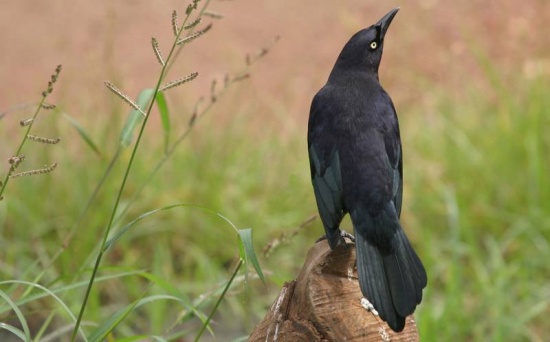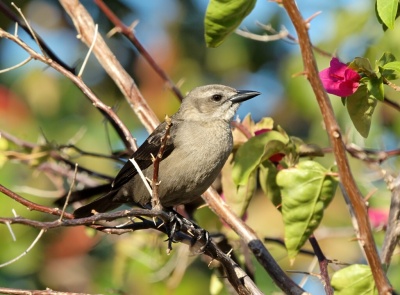- Quiscalus lugubris
Identification
24-28 cm
Male is black with a metallic sheen that is either green, violet, or steel-blue. It has a tail that is V-shaped and whitish eyes.
The female has grayish underside, darker brownish-gray upperside and a light supercilium at least on some islands, while she is darker and even can have some glossy black areas on other islands.
Male is larger than female.
Distribution
Present in the Lesser Antilles from Anguilla and south - probably introduced on some of the northern islands including Antigua and Barbuda. Outside the Caribbean, also present on Trinidad, and Eastern Colombia through Northern Venezuela (including islands such as Isla Margarita etc), the Guianas, and North-Eastern Brazil.
Taxonomy
Subspecies[2]
Clements Checklist mentions 8 subspecies.
- Q. l. guadeloupensis:
- Montserrat, Guadeloupe, Marie Galante, Dominica and Martinique
- Q. l. inflexirostris:
- Q. l. contrusus:
- Q. l. luminosus:
- Lesser Antilles (Grenada, the Grenadines and Islas Los Testigos)
- Q. l. fortirostris:
- Q. l. orquillensis:
- Islas Los Hermanos (off Venezuela)
- Q. l. insularis:
- Isla Margarita and Islas Los Frailes (off Venezuela)
- Q. l. lugubris:
According to Raffaele1, the 5 Caribbean subspecies have different song dialects, and there is some differences in female plumage as well. Prime suspect for a future split?
Habitat
Limited to open areas, including residential.
Behaviour
Breeding
It breeds in colonies. A deep cup nest is built in a tree. The 2-4 white eggs are incubated for 12 days. The young fledge 14 days later.
Diet
The diet includes insects and invertebrates.
References
- Raffaele et al. 1998. Birds of the West Indies. Christopher Helm, London. ISBN 0713649054
- Clements, JF. 2008. The Clements Checklist of Birds of the World. 6th ed., with updates to December 2008. Ithaca: Cornell Univ. Press. ISBN 978-0801445019.
- Wikipedia
Recommended Citation
- BirdForum Opus contributors. (2024) Carib Grackle. In: BirdForum, the forum for wild birds and birding. Retrieved 24 April 2024 from https://www.birdforum.net/opus/Carib_Grackle
External Links






